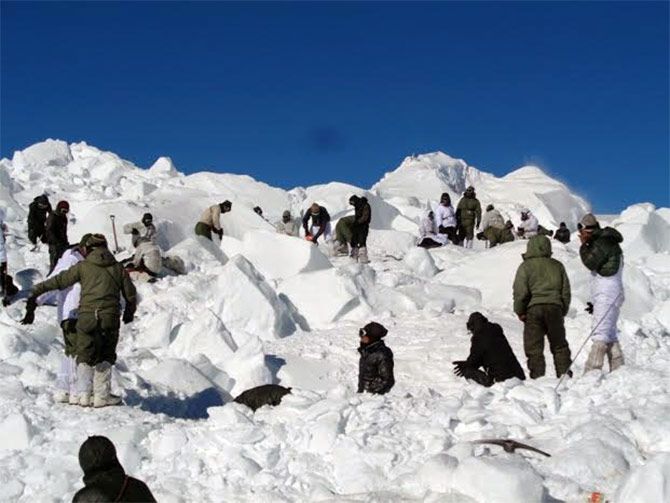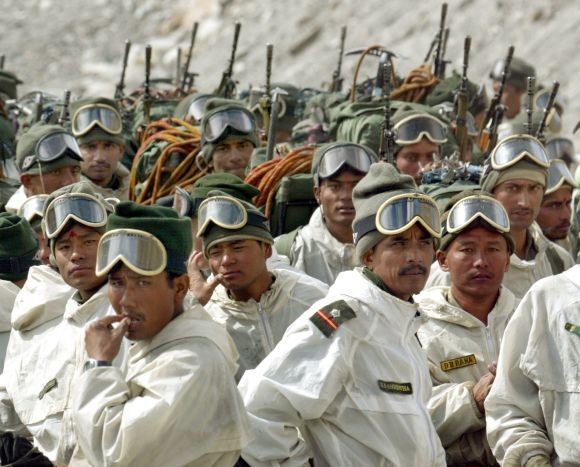 | « Back to article | Print this article |
'Perhaps the finest example is from the current avalanche itself.'
'The Commanding Officer of 19 Madras (the affected unit) is Colonel Um Bahadur Gurung, a Gurkha who joined the Madras Regiment.'
'He inspired this recovery operation at 19,500 feet, a unique feat by itself.'
'He knew that if it was delayed the chances of finding the mortal remains in the Saltoro's ice would be impossible.'
'He did not pass orders from his base at Kumar (15,000 feet) or gave directions; he simply went there himself, inspiring the multitude that followed.'
Lieutenant General Syed Ata Hasnain (retd), who has served on the Siachen Glacier, salutes the incomparable spirit of the Indian Army.

The 'Great Awakening' -- this is the title that history may well bestow on the Sonam Avalanche at the Northern Siachen Glacier and all the connected events of the last few days. Just in case you think it is an awakening for the Indian Army, think again.
The Indian Army remains awake as an institution all 24x7 and all 365 days of the year, doing what it does and ensuring excellence in every endeavour. It is the public which forgets what the army does and needs that Awakening. No doubt, life is fast paced in today's world and in spite of omnipresent media, awareness is only focused on the immediate environment.
That restricts vision and the ability to appreciate what national institutions like the Indian armed forces do. The common refrain is that there being no ongoing war the armed forces would be relaxing. People forget we are always at war and there is no need to elaborate that except to state that with disputed borders and fragile internal security you won't ever have the armed forces in 'relax mode.'
Mercifully the quest for at least basic knowledge on what warriors of different shades do is on the rise. The media really came to the fore in the last few days to throw up Siachen, an issue probably at some remote corner of the public mind.
Full front page stories on past operations are something uniquely new in the Indian print media, but it has happened. People need to be repeatedly told the saga of the capture of Quaid Post in 1987 by Major (later Brigadier) Virender Singh, Vir Chakra, and Subedar Major (Honorary Captain) Bana Singh, Param Vir Chakra. It should be folklore.
From the media trends that I have followed it appears that there is considerable interest in knowing what the living and operating conditions at the glacier are. Much has been spoken about that on the television channels. There is equal thirst to know why the army is there at all and can we just give it all up and withdraw when the ground is so inhabitable?
I won't answer the last one in this essay, but to my mind the most important question the public should be asking is -- How does the Indian Army make a Mission Impossible into Mission Possible? There has to be a unique chemistry which drives men to do such impossible feats.
Firstly, let me remove one misnomer and I am not being unfair in this. The Pakistan army claims that it is fighting or at least is deployed at Siachen. Siachen is an oft repeated word in its military-related television dramas, but sadly for them they cannot even see Siachen which is curtained from their view by the mighty Saltoro Ridge where India's flag flutters proudly.
Siachen for them is the intention and the dream they hope for. Watching Pervez Musharaf on television and his continuous rant defending Pakistan's sponsorship of the proxy war in Jammu and Kashmir leaves me to only think how we can ever consider a mutual pull back from Siachen without looking at the feasibility of yet another backstab. The very next spring we will find Pakistan's flag at Saltoro.
Top of the head suggestions such as technological monitoring to get early warning of Pakistan reneging on an agreement are passe. It is not easy -- in fact almost impossible -- to respond in glaciated conditions and hope for any success.
Someone correctly pointed out the other day the borders finally need boots to be there and fragile borders need many of them.
So how does the Indian soldier gel?
Perhaps the finest example is from the current avalanche itself.
The Commanding Officer of 19 Madras (the affected unit) is Colonel Um Bahadur Gurung, a Gurkha who joined the Madras Regiment. The man is obsessed with his men, his regiment, his cap badge and his lanyard. He inspired this recovery operation at 19,500 feet, a unique feat by itself.
He knew that if it was delayed the chances of finding the mortal remains in the Saltoro's ice would be impossible. He did not pass orders from his base at Kumar (15,000 feet) or gave directions; he simply went there himself, inspiring the multitude that followed.
The men knew that if it ever happened to them their mortal remains would never go un-honoured as long as men like Colonel U B Gurung exist.
It is an ode to the Indian Army's regimental system that makes men like Colonel Gurung. An erstwhile Gurkha jawan, who came up by sheer dint of hard work to make it to the Army Cadet College from where qualified and selected jawans can graduate as officers.
True to the army's system of officer jawan integration Gurung was actually commissioned into the Intelligence Corps, but attached for an initial period with 19 Madras. He decided to stay on, thus earning the title 'Gurkha Tambi.' The Tambis of the Madras Regiment became his life and no doubt that of his family.
Officers of the Indian Army live in two worlds: The regimental and the native; the latter is usually overpowered by the dominance of regimentation. The men take to the officers and the officers to the men on a simple principle of honour and brotherhood. Progressively, the officers' families similarly get wedded to regimental culture.
Those uninitiated to the ways of the army may find it extremely revealing that a Sikh or a Hindu by faith, who is in command of a pure Muslim sub unit such as the Grenadiers, joins his men in prayers and fasting through Ramzan, all 30 days.
The vice versa is equally true, each of them know more about the faith and cultural practices of their men then the men themselves know. It is by tradition and by the culture of 'passing it on' that the system survives.

There is nothing written except some principles of leadership but each regiment of the Indian Army has culled its own unique way of grooming its leaders. Interfere with that and you will break the very edifice of the system on which rests the effectiveness of the organisation.
When a band of such men who are truly 'all for one and one for all' arrive at an operational area, the bonding is even stronger. They are together day in and day out, facing the same threats and the same elements; the officer will shield his men from danger by being the first ahead and the men will shield the officer from being the first.
In this awkward tussle it is the ethos which prevails and cuts through the environment of life threats and more. This is what you call the indomitable spirit of the Indian warrior. It has to be experienced to be believed.
When you are at the head of a group/sub unit of soldiers, everything in them is owned by you, including their lives. They know it and you know it.
That is why an officer's personality changes as he witnesses casualties among his men. He will put himself in harm's way for the sake of his men and feel the regret and remorse of any losses, all his life.
When such spirit prevails in an environment where challenges come in droves and men are tested to the extremes of their will none can let the other down.
I can recall a moment in the jungles of Sri Lanka in 1988 when we were battling one of the largest LTTE camps against the best trained LTTE cadres. Exhaustion had overtaken me after almost four days and nights of continuous nerve wrecking operations.
There was a brief lull in battle and as I lay exhausted on a grass patch in the jungle little did I realise that I was exposing myself to a flank from where I could be easily shot.
Sleep overtook the senses and when I woke up four hours later I found myself surrounded by a wall of bullet proof jackets, BPJs. The men did not wish to disturb me and knew I was vulnerable. They removed their BPJs and created that wall. That is the only moment in my 40-year career when I silently wept with emotion.
Modernisation et al has done nothing to this bond, in fact it has only reinforced it. Old soldiers bemoan the loss of strength of the officer-man relationship today, but they need to be reminded and informed that nothing has changed.
The youth of today is a little more boisterous and the media a little more open, that is why you hear an odd case of indiscipline. Classically, nothing has changed. It is for the public and society to remain reassured.
Moments such as these when the nation has been emotionally linked with the tragedy at Sonam must be grabbed to convey and reassure that the Indian Army remains the same steadfast army that it always was.
No unaware authority should ever tamper with its unique fabric of brotherhood, otherwise he will only be compromising the security of this country.
Pay it or do not pay it, equip it or do not equip it, this army will still deliver when it comes to the crunch and if it does, it will be because of the uniqueness of its sense of honour and brotherhood.
Lieutenant General Syed Ata Hasnain (retd) had the unique experience of serving in almost all the turbulent spots where the Indian Army is deployed, including Siachen, Kashmir and Sri Lanka.
He is currently associated with the Delhi Policy Group and the Vivekanand International Foundation.